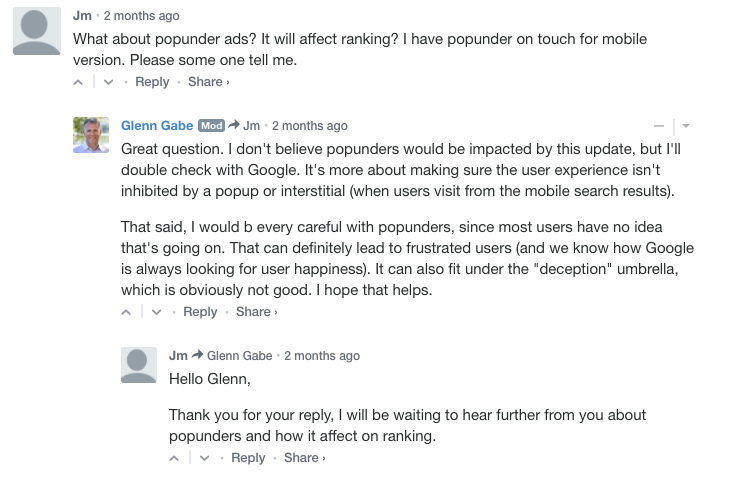When Google announced they would penalize mobile websites displaying distracting pop-up messages, most of us went cross-eyed with the emotional paradox of it all.
As mobile users, we rejoiced at the freedom of accessing content without having to bypass an ad first.
As marketers, we panicked because mobile interstitials were a valuable source of leads to our websites.
On January 10, 2017, Google began enforcing their new interstitials penalty, frowning on “pages where content is not easily accessible to a user on the transition from the mobile search results.” Basically, if your mobile website is running a pop-up banner, it may not rank as high anymore. SitePoint says penalties will only affect sites in the mobile algorithm rather than desktop, which seems fair, but with the mobile-first algorithm it doesn’t really matter.
However, not every website will be affected by the penalty. Sites with interstitials containing legal information, logins on password protected sites, and banners that are small and easily dismissed are in the clear. The penalty only applies to:
- Websites that display pop-up interstitials that cover the content as users try to enter their site or while they’re on the page
- Websites that include an interstitial that users have to close before they can access the content
- Websites that have the main content below the fold and a message that resembles an interstitial above the fold
Search Engine Land cited Google’s main issue with interstitials in a mobile environment: They can be problematic on smaller devices with smaller screens. The term problematic is vague, but the point is that pop-up messages are being discouraged during the entry stages of the mobile experience anymore. The question now is: What can marketers and business owners do if their site was negatively affected by Google’s mobile interstitials penalty?
Lessons From Past Interstitial Updates
Google began targeting interstitials for app downloads on websites in November 2015. At the time, Yelp speculated on why Google wouldn’t target other interstitials, arguing that it was to keep their search monopoly; searching within a mobile app bypasses Google’s mobile search.
Google reported no such thing, according to Marketing Land. Instead, Google said their decision was based on a study where interstitial engagement increased by being less intrusive. This rationale and the study were later criticized for focusing only on one type of market and website.
Furthermore, intrusive interstitials sometimes works. The article noted how important intrusive interstitials had been in increasing app downloads by 100% for Pinterest and 300% for Airbnb. Despite these claims and important gains, Google moved full steam ahead with additional ranking factors that put mobile users first and ad messages last.
Penalizing mobile websites for app download interstitials was the precursor to the update just released that penalizes all interstitials. Looking at how sites recovered from the app interstitials update in 2015 is thus the best place to begin understanding how to recover from the broader mobile interstitials update now upon us.
Mini Case Study: “Wazumbi” and Google Play
Wazumbi is a username, not the name of an app. Unfortunately for this user, their app was banned from the Google Play store for showing app download interstitials. Wazumbi asked the broader community what they thought of Google’s message.

A few users told Wazumbi it was because he was showing app download interstitials outside of the app.
One particular user by the name of “MarcTG” had a similar experience with his app being removed from Google Play for showing interstitial ads. He disagreed with Google’s assessment that his interstitials were violating guidelines, so he took screenshots to prove it and included these in his reply to Google.
He recommended others do the same, to show Google how the interstitial was being displayed, and make their case. MarcTG’s app was reinstated in the app store 24 hours after he responded.
Unfortunately, Google was unresponsive to Wazumbi’s attempts to get back into Google Play.
The experience app developers had and the challenges they faced after the app download interstitials update is not unlike what digital marketers are facing now. The case study above demonstrates that Google runs the show on their properties. Without proper documentation or a strong case to plead to Google, violators may simply be ignored.
Violators that can prove their interstitials are no longer an issue or were never an issue with screenshots and other supporting material have better chances of re-inclusion. The latest update will look a little different.
What Impact Will the Mobile Interstitials Update Have?
Whenever Google rolls out a new update, the actual impact on websites and even apps can vary. When search marketers hear “penalty” they begin to assume the worst…like a manual action. In such a case, marketers receive a notice of violation via Google Search Console and are typically required to submit a reconsideration request available therein. Marketers should address the violation and submit a thoughtful reconsideration request when they can demonstrate to Google they’ve fixed the problem.
But the interstitials update isn’t that severe, and more importantly, this update is not considered a “penalty” in the strictest Google sense of the word, but an algorithmic update. This is a new set of rules for success, not a slap on the wrist for an offense (we’ll come back to reconsideration requests later).
Glenn Gabe has some of the best coverage on the update so far and was kind enough to respond to the matter for me. He says:
“It’s not a manual action (or penalty). It’s an algorithmic demotion for mobile pages employing popups or interstitials that cover a majority of the content on the page. And I don’t envision Google providing any type of notification in Google Search Console (GSC). If they did provide any information, it would probably fall under the mobile usability reporting. For example, “this URL is using a mobile popup covering a majority of the content”. Or something like that… But I wouldn’t bank on that coming any time soon.”
A potential drop in rankings is the worst it can get. But like many marketers, Glenn asked, “How extreme would it be? Would there be loopholes? How would it impact branded versus non-branded queries? Would large-scale sites be impacted as much as smaller sites?”
To understand the answers to these questions, Glenn began monitoring a few dozen sites showing mobile interstitials once the roll out happened. Since the update, he has ramped up to monitoring 70 websites, and he has not seen any major loss in rankings in desktop or mobile across the 70 sites showing mobile interstitials thus far. This is great news for digital marketers.
For greater insights on the matter, one commenter asked Glenn in his original coverage what he thought about popunder ads in the context of the update:

Despite a lack of clarity, Glenn recommends marketers continue monitoring rankings to understand if they’ve been impacted by the update. You should also stay tuned to his post for ongoing updates on how the mobile interstitials update is affecting other websites.
Mobile Interstitials Penalty Preparations
Environmental scientists use the precautionary principle of being safe rather than sorry to prevent irreversible damage in the absence of all the facts and data necessary. Not knowing how much the update would impact their mobile websites, some marketers wisely prepared for the update. SEJ breaking news writer Matt Southern came through with as-it-happens advice, giving 10 ways to avoid the mobile interstitials penalty, summarized here:
- Make sure your content is readily available to mobile users.
- Make sure your pop-ups serve a purpose (legal, age verification, or otherwise).
- Make sure ads are gone for good and don’t reappear as users scroll the page.
- Consider the long-term benefit of organic ranking over the short-term profit loss from interstitial removal.
- Develop a less intrusive content strategy for leads.
- Don’t misinterpret the removal of the mobile-friendly label — mobile matters!
- Enrich your desktop interstitials because they are still allowed.
- WordPress sites using plugins for interstitials may be able to make small adjustments and be fine as long as the banner doesn’t block the main content..
- Mobile interstitials are still allowed as users exit a site’s content — say whaaat!?
- Mobile interstitials can still be displayed between website pages.
The ability to display interstitials on desktop as well as in between pages on mobile sites and during mobile exits means not all is lost. Unfortunately, the unprepared may have already been affected by the interstitials update.
Back Up Plan for Recovery
Site owners who have recently lost a significant amount of traffic and/or search ranking positions may be wondering if they’ve been hit by Google’s mobile interstitial penalty. Some users may mistakenly think they have been hit by the mobile interstitials penalty but actually it was another factor. In one example, a site owner thought their site had been disavowed for mobile interstitials but it was more likely to have been considered just a low-quality source of content. Nothing could be worse than scaring your client or your team with improper risk communication about the wrong penalty — yikes!
If you believe the interstitials update is indeed the cause of the drop, the first thing to do is take a step back and figure out if the risks outweigh the benefits; marketers may want to consider actually keeping the interstitial there.
Marketing Land wrote about Airbnb’s decision to run mobile interstitials despite the update. With a quantitative analysis, Airbnb figured out that the loss in search engine rankings didn’t outweigh the traffic and revenue gained from the interstitial being there. But user beware: Endorse that strategy only using data-driven decisions and at your own risk.
However, if the right business decision is to remove the intrusive interstitial and you’re 100% sure your site was affected by the mobile-interstitials algorithm update, we better get you started. Here is a quick plan of ordered, escalating steps; hopefully the problem is solved before you need to try them all:
Step 1:
Talk to the client or to your team and explain to them why you’re making changes to the site and the potential impacts. Your team has to recover as one, with an understanding of Google’s policies so this doesn’t come down on you, dear marketer.
Step 2:
Remove it. Replace it with a less intrusive version, or focus on placing interstitials in between pages on your website or on exits.
Step 3:
Websites should signal to Google that they’ve made improvements, in order to speed up the process and let the algorithm do its work as soon as possible. In addition to a quick XML sitemap resubmission, search marketers can go to Google console and then “fetch and submit” their main URLs, signalling to Google to recrawl these pages. Doing so increases the chances of recovering any losses in rankings more quickly.
The above steps treat the interstitials as an algorithmic update and not necessarily as a “penalty.” Indeed, Google’s announcement didn’t use the word. That said, just because Google doesn’t label it as such, doesn’t mean you shouldn’t treat a ranking drop as if it was a penalty, especially if you don’t see any recovery after the first three steps.
Simon Abramovitch is a veteran SEO who gave me his thoughts on situations like this. He says:
“If Google has a problem with my client and rankings are suffering – whether they call it an algorithmic update or a penalty or whatever – my goal is the same: recovery. If I’m still not seeing improvement after I take the proper technical steps, I’m going to do my best to open the lines of communication.”
If steps 1-3 don’t do the trick, consider the following two optional steps:
Step 4:
File a reconsideration request to Google, making your case with all relevant supporting details. You have nothing to lose in doing so but the time taken to put it together.
Step 5:
If your request with Google still doesn’t produce results, the last resort would be to take to the Webmaster Forum and plead your case publicly. Others may have advice for you, and there is a greater chance of your situation landing in front of someone’s eyes at Google.
If your website has a unique situation regarding mobile interstitials, be sure to include those details in your communication. One particular website put up an interstitial (mobile and desktop) every weekend to let their users know they had taken their site down to observe the Sabbath. They asked Google if they would make any religious exceptions to the new update. This was a particular case and this website owner was advised to “consider putting the website into a maintenance mode on the Sabbath,” and given a link to instructions on how to do that.
If you need to show an interstitial on your mobile website to alert users that the site is down for maintenance or any other reason, you may want to consider putting your website into maintenance mode. That way, when Google crawls the site, it won’t penalize it for having the interstitial there.
Mobile site owners shouldn’t worry as much as they initially thought and interstitials on mobile websites are not yet causing widespread penalties. Those that may be affected are sometimes choosing to be like Airbnb, while others can make a few tweaks to their websites to ensure they stay in the clear. Monitor your own rankings if you’ve been showing interstitials. Monitor Google webmaster forums for new communication regarding the mobile interstitials update. For additional information from Google’s product forums on interstitials, read here.
Google Can’t Please Everyone
The main issue Google has now with almost all types of interstitials, not just ones prompting app downloads, pertains mostly to mobile UX. Most of us agree that the mobile search experience should be uncluttered and free of distraction. Yet marketers rely on display real estate, especially on their own sites, to capture new leads and conversions at key times, like when users are entering a website. Having said that, not all interstitials are hated. Personally I love Forbes’ quote of the day whenever I go to their site. Google can’t please everyone though.
Google’s position on interstitials was part of their fundamental mission to create the best search experience possible. In a mobile context, the search experience is even more important because users are on the go and need information fast. Google definitely recognizes that need and is doing everything it can to help, whether marketers like it or not.
A special thank you to Glenn Gabe and Simon Abramovitch for sharing their insights with me.
Image Credits
Feature Image: Unsplash/Rodion Kutsaev
All screenshots by Chandal Nolasco da Silva. Taken February 2017.
Screenshot 1: Discussion from Anywhere Software Forum
Screenshot 2: Comments from G-Squared Interactive Blog Post




